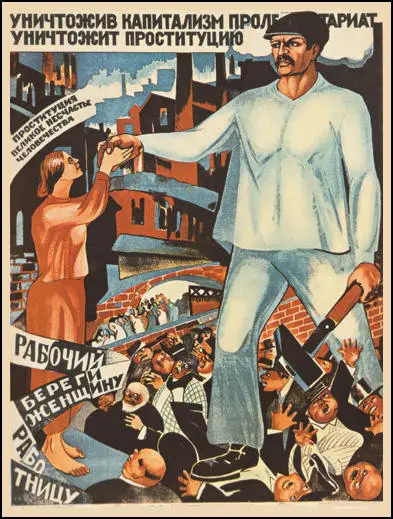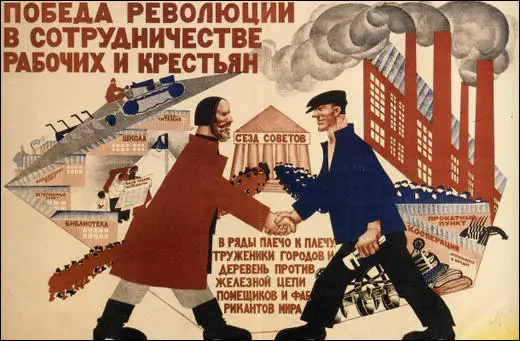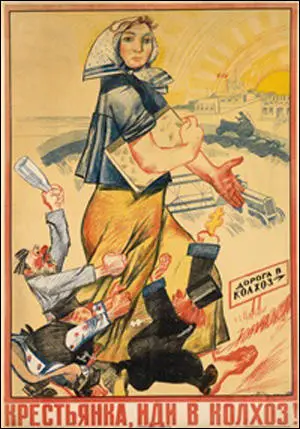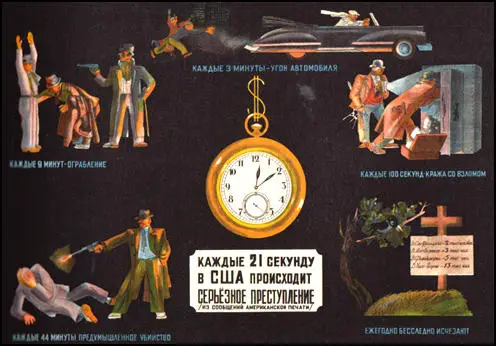Mikhail Cheremnykh
Mikhail Cheremnykh was born in Tomsk on 18th October, 1890. He graduated in 1916 from the Moscow School of Painting, Sculpture, and Architecture. A supporter of the Bolshevik Revolution he became a supplier of communist propaganda.
A newspaper cartoon of Lenin in November 1918 was turned by Viktor Deni into the first poster based on the Bolshevik leader, Comrade Lenin cleans the Earth from Scum (November, 1920). Victoria Bonnell, the author of Iconography of Power: Soviet Political Posters under Lenin and Stalin (1999) points out: "Deni poster depicts Lenin standing on the globe, sweeping with a large broom. He towers over his enemies (tsar, priest and capitalist) who are pictured as small satirical figures leaping to escape the broom."
One of the founders of the Socialist Realist art movement he produced posters in support of Joseph Stalin such as Peasant Women, Go Into The Collective Farms! (1930), Congratulations (1930) and That the Knife Might Fall From This Claw (1938). He was awarded the State Prize of the USSR in 1942,
Mikhail Cheremnykh died in Moscow on 7th August, 1962.



Mikhail Cheremnykh, Peasant Women, Go Into The Collective Farms! (1930)

Primary Sources
(1) Maria Lafont, Soviet Posters (2007)
Mikhail Cheremnykh. People's Artist of the Russian Federation. Active member of the USSR Academy of Fine Arts, USSR State Prize laureate, was also awarded "The Badge of Honor" and other medals. In 1916 he graduated from the Moscow School of Painting, Sculpture and Architecture. Founder of Soviet satirical graphical art and poster design... From 1922 onwards contributed to many satirical magazines; also active as a painter in oils, graphic artist, stage designer, and book illustrator.
(2) Victoria Bonnell, Iconography of Power: Soviet Political Posters under Lenin and Stalin (1999)
The year 1920 witnessed some important shifts in the style of visual propaganda... In this atmosphere of rapid change in political art, Viktor Deni designed the first significant political poster featuring Lenin. Issued in November, 1920, Comrade Lenin Cleanes the Earth of Scum, presented a more elaborate version of Mikhail Cheremnykh's November 1918 newspaper drawing. The Deni poster depicts Lenin standing on the globe, sweeping with a large broom. He towers over his enemies (tsar, priest and capitalist) who are pictured as small satirical figures leaping to escape the broom.
(3) David King, Red Star over Russia (2010)
The Bolsheviks equipped and mobilized agitational propaganda trains during the Civil War, sending them to all parts of Russia to inform the population about the ongoing struggles in defence of the revolution and to help organise lectures, meetings and discussions on the meaning of the new workers' state.
The first train named after Lenin, went into service on August 13, 1918. Others soon followed, bearing titles such as "October Revolution", "Red East", "Soviet Caucasus" and "Red Cossack". The carriages were famously decorated with paintings, graphic or satirical, on subjects that reflected the names of the trains and the places where they were headed.
(4) Anthony Rhodes, Propaganda: The Art of Persuasion (1987)
For the masses, propaganda had to be simple, categoric, direct. Within a short time all forms of printing - books, newspapers, pamphlets, and posters - were in the hands of the State Publicity Corporation, which controlled not only the publishing operations but the printing machinery and paper supply. It was endowed with a censorship department which examined all book manuscripts, film scripts, drawings, music, and even maps. On November 12, 1920, the Main Political Education Committee of the Republic was set up, branches of which were attached to the political division of every region, district, town and village.
Student Activities
Russian Revolution Simmulation
Bloody Sunday (Answer Commentary)
1905 Russian Revolution (Answer Commentary)
Russia and the First World War (Answer Commentary)
The Life and Death of Rasputin (Answer Commentary)
The Abdication of Tsar Nicholas II (Answer Commentary)
The Provisional Government (Answer Commentary)
The Kornilov Revolt (Answer Commentary)
The Bolsheviks (Answer Commentary)
The Bolshevik Revolution (Answer Commentary)
Classroom Activities by Subject
